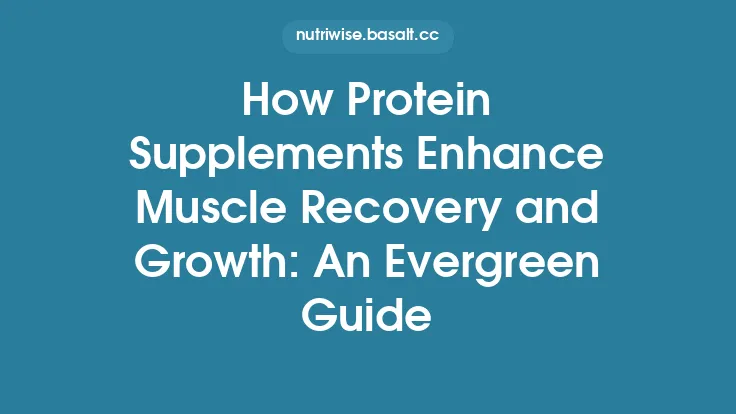Protein supplements have become a staple in the sports‑nutrition toolbox, yet many athletes and fitness enthusiasts still wonder what they actually are, how they differ, and why they matter for performance. This article provides a comprehensive, evergreen look at protein supplementation—covering the main categories of products, the physiological advantages they confer, and the ways they can help you train harder, stay stronger, and sustain high‑intensity effort over time. The focus is on the science behind the supplements and practical considerations for anyone looking to integrate them into a performance‑oriented routine.
The Core Categories of Protein Supplements
While the market offers dozens of branded powders, bars, and ready‑to‑drink formulas, most products can be grouped into a handful of scientifically defined categories. Understanding these groups helps you recognize what you’re consuming and why each type behaves the way it does in the body.
| Category | Typical Source | Processing Method | Key Characteristics |
|---|---|---|---|
| Protein Concentrates | Dairy (milk), egg, or plant material | Low‑to‑moderate filtration (typically 30‑80 % protein) | Retain a modest amount of lactose, fat, and bioactive compounds; relatively inexpensive |
| Protein Isolates | Dairy, egg, or plant | High‑grade filtration (≥90 % protein) | Minimal non‑protein constituents; fast dissolution; suitable for low‑carb or low‑fat protocols |
| Hydrolyzed Proteins (Hydrolysates) | Any source (commonly whey, casein, or soy) | Enzymatic hydrolysis breaks peptide bonds into short chains | Extremely rapid absorption; low allergenicity; often used in clinical nutrition |
| Specialty Animal‑Based Proteins | Egg white, beef, pork, collagen (derived from skin, bone, or cartilage) | Varies (dry‑powdering, enzymatic extraction) | Provide unique amino‑acid profiles (e.g., high leucine in egg, high glycine in collagen) |
| Novel and Emerging Proteins | Insects, algae, cultured‑cell meat, mycoprotein | Advanced processing (dry‑extraction, fermentation) | Sustainable sourcing; distinct functional properties; still gaining regulatory clearance |
Each category delivers a different blend of macro‑ and micronutrients, absorption kinetics, and functional benefits. The choice among them often hinges on personal tolerance, dietary restrictions, and the specific performance goal you are targeting.
Physiological Benefits Beyond Muscle Building
When people think of protein, the first thing that comes to mind is muscle hypertrophy. While that is a well‑documented effect, protein supplements also influence a broader spectrum of physiological processes that are directly relevant to athletic performance.
1. Enhanced Nitrogen Balance
Protein provides the nitrogen atoms required for the synthesis of virtually every cellular component. Maintaining a positive nitrogen balance helps preserve lean tissue during periods of caloric deficit or high training volume, preventing the catabolic erosion that can impair power output and endurance.
2. Support of Immune Function
Intense training temporarily suppresses immune competence, increasing susceptibility to infections. Certain amino acids—particularly glutamine, arginine, and cysteine—serve as substrates for immune cells (e.g., lymphocytes, macrophages). Supplementing with high‑quality protein can replenish these pools, reducing the incidence of training‑related illness.
3. Hormonal Modulation
Amino acids act as precursors for several hormones that regulate metabolism and stress responses. For example, tyrosine is a building block for catecholamines (dopamine, norepinephrine), which influence focus and perceived effort during prolonged exercise. Adequate protein intake can help sustain optimal hormone synthesis under training stress.
4. Bone and Connective‑Tissue Health
Collagen‑rich proteins supply glycine, proline, and hydroxyproline—amino acids essential for the synthesis of collagen fibers in tendons, ligaments, and bone matrix. Regular ingestion of collagen peptides has been linked to improved joint comfort and reduced injury risk, enabling athletes to maintain training consistency.
5. Metabolic Flexibility and Energy Provision
During prolonged endurance events, the body increasingly relies on gluconeogenesis—the conversion of amino acids into glucose. Protein supplements can supply glucogenic amino acids (e.g., alanine, glutamine) that help sustain blood glucose levels when glycogen stores are depleted, delaying fatigue.
6. Satiety and Body‑Composition Management
Protein exerts a strong satiety effect through hormonal pathways (e.g., peptide YY, GLP‑1) and by slowing gastric emptying. For athletes managing weight classes or aiming for lean mass, protein supplementation can aid in appetite control without compromising nutrient intake.
How Protein Supplements Bolster Athletic Performance
The performance‑enhancing mechanisms of protein are multifaceted, extending from cellular metabolism to central nervous system function. Below are the primary ways protein supplementation can translate into measurable improvements on the field, track, or gym.
1. Preservation of Contractile Proteins During High‑Intensity Work
During repeated bouts of sprinting or heavy lifting, muscle fibers undergo micro‑damage. A readily available pool of amino acids helps repair these contractile proteins more quickly, allowing athletes to sustain higher power outputs across successive sets or intervals.
2. Glycogen Sparing Through Amino‑Acid Oxidation
When amino acids are oxidized for energy, they reduce the reliance on carbohydrate stores. This glycogen‑sparing effect is especially valuable in endurance sports where carbohydrate depletion is a primary limiting factor. Studies have shown that athletes consuming protein during long‑duration exercise exhibit higher remaining muscle glycogen at the end of the session.
3. Reduction of Central Fatigue
The “tryptophan hypothesis” suggests that elevated plasma free tryptophan competes with branched‑chain amino acids (BCAAs) for transport across the blood‑brain barrier, increasing brain serotonin and promoting perceived fatigue. By ingesting protein rich in BCAAs, athletes can blunt this competition, potentially delaying the onset of central fatigue during prolonged effort.
4. Improved Neuromuscular Transmission
Amino acids such as glutamate and aspartate serve as excitatory neurotransmitters, while glycine and GABA are inhibitory. Balanced intake of these amino acids via protein supplementation can support optimal neuromuscular signaling, translating to sharper reaction times and more precise motor control.
5. Thermoregulatory Support
Protein metabolism generates a higher thermic effect compared with fats or carbohydrates. In cold‑environment training, this additional heat production can aid in maintaining core temperature, indirectly supporting performance by reducing the metabolic cost of thermoregulation.
6. Recovery of Functional Capacity Between Sessions
While not a direct focus on muscle hypertrophy, the rapid replenishment of amino‑acid pools after a training bout restores the capacity for subsequent high‑quality sessions. This “functional recovery” is crucial for athletes who train multiple times per day or have congested competition schedules.
Practical Guidelines for Incorporating Protein Supplements
To reap the performance benefits described above, it is essential to align supplementation with individual needs, training load, and overall nutrition strategy. The following considerations are grounded in peer‑reviewed research and consensus statements from sports‑nutrition societies.
Determine Your Daily Protein Target
- Endurance athletes: 1.2–1.6 g · kg⁻¹ · day⁻¹
- Strength/power athletes: 1.6–2.2 g · kg⁻¹ · day⁻¹
- Mixed‑modality athletes: 1.4–2.0 g · kg⁻¹ · day⁻¹
These ranges include protein obtained from whole foods; supplements are used to fill any shortfall.
Select the Appropriate Formulation
- Fast‑absorbing isolates or hydrolysates are ideal when you need a rapid amino‑acid surge (e.g., during a training block with limited recovery time).
- Concentrates or specialty proteins (egg, beef, collagen) can be incorporated into meals or snacks where a slower release is acceptable.
- Novel proteins (insect, algae) may be chosen for sustainability goals or to diversify amino‑acid intake.
Timing Relative to Training
Although the precise timing window is a nuanced topic, a practical rule of thumb is to consume a protein dose within a few hours before or after a demanding session. This ensures that amino acids are present in the bloodstream when metabolic demand peaks.
Dosage per Serving
Research indicates that 20–40 g of high‑quality protein per serving maximizes the acute rise in plasma amino‑acid concentrations without causing unnecessary excess. For hydrolysates, the lower end of the range is often sufficient due to their rapid uptake.
Hydration and Co‑Ingestion
Protein powders are typically mixed with water, milk, or plant‑based beverages. Adequate fluid intake supports renal clearance of nitrogenous waste products. When using protein in conjunction with carbohydrate sources (e.g., fruit smoothies), the combined osmolality should be considered to avoid gastrointestinal discomfort.
Safety and Contraindications
- Renal health: Individuals with pre‑existing kidney disease should consult a healthcare professional before increasing protein intake.
- Allergies: Egg, dairy, and beef proteins can trigger allergic reactions; hypoallergenic isolates (e.g., pea or rice) are alternatives.
- Digestive tolerance: Hydrolyzed proteins often cause less bloating and gas compared with concentrates, making them suitable for sensitive stomachs.
Regulatory and Quality Assurance
Select products that have undergone third‑party testing (e.g., NSF Certified for Sport, Informed‑Sport) to verify label accuracy and the absence of prohibited substances. While this article does not delve into label reading, awareness of certification can safeguard against contamination.
Emerging Trends and Future Directions
The protein‑supplement landscape is evolving rapidly, driven by advances in food technology, sustainability concerns, and personalized nutrition.
- Precision Nutrition Platforms – Integration of genetic, metabolomic, and training data to tailor protein type, dose, and timing for each athlete. Early trials suggest that individualized protocols can improve performance markers beyond generic recommendations.
- Sustainable Protein Sources – Insect‑derived powders (e.g., cricket, mealworm) and microalgae (spirulina, chlorella) offer high protein density with lower environmental footprints. Ongoing research is evaluating their digestibility and amino‑acid profiles relative to traditional animal proteins.
- Bioactive Peptide Enrichment – Processing techniques that isolate specific peptide sequences (e.g., lactoferrin, β‑casein‑derived peptides) aim to deliver targeted benefits such as enhanced immune response or improved gut barrier function.
- Hybrid Formulations – Combining protein with functional ingredients like electrolytes, adaptogens, or nootropics to create “all‑in‑one” performance drinks. While promising, these products require rigorous testing to confirm additive or synergistic effects.
- Regulatory Evolution – As novel proteins gain market share, regulatory bodies are updating definitions of “protein supplement” and establishing new safety standards. Staying informed about these changes will be essential for manufacturers and consumers alike.
Bottom Line
Protein supplements are more than just a shortcut to meeting daily protein quotas; they are versatile tools that can enhance nitrogen balance, support immune health, modulate hormones, protect connective tissue, and directly influence energy metabolism—all of which translate into tangible performance gains. By understanding the distinct categories of protein products, recognizing the breadth of their physiological benefits, and applying evidence‑based dosing strategies, athletes can strategically incorporate supplements into their training regimen to train harder, recover faster, and stay competitive over the long term.





